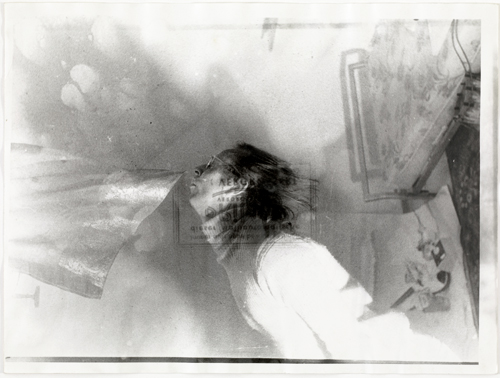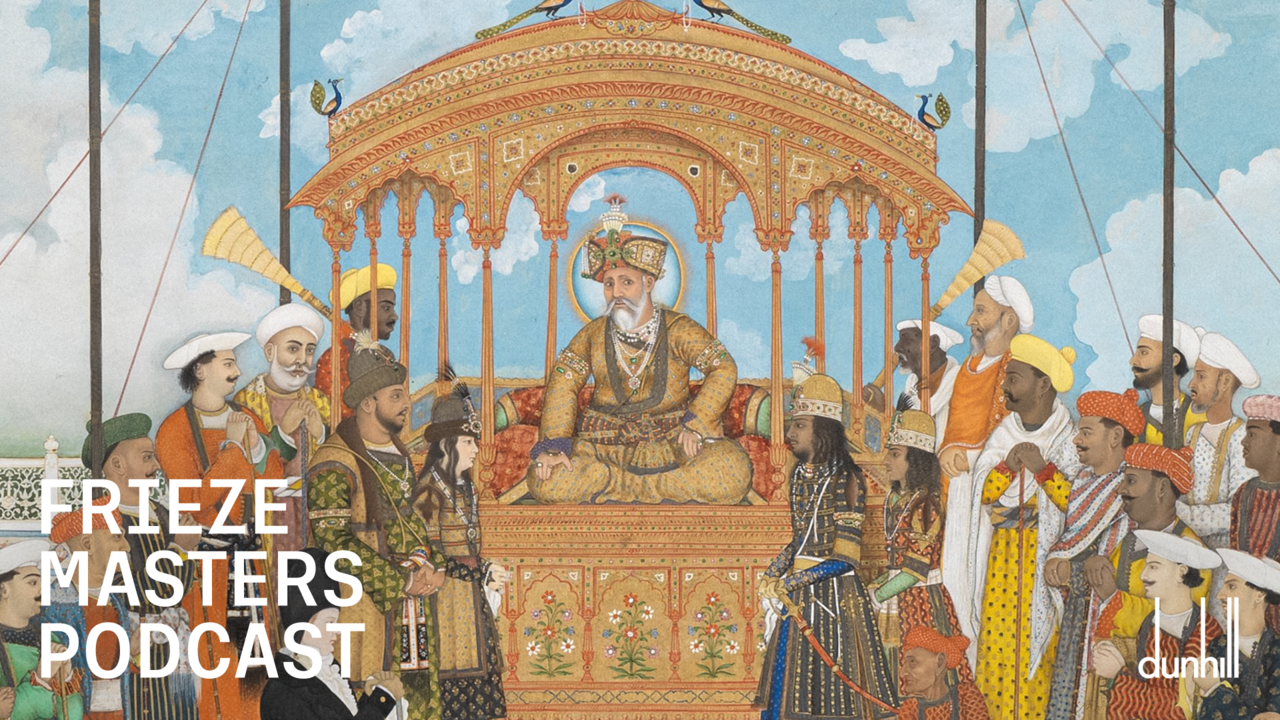Sigmar Polke
MoMA
MoMA

A hazy matrix of half-tone dots converging into Lee Harvey Oswald’s grim profile (Rasterzeichnung (Porträt Lee Harvey Oswald), 1963); the blithe jumble of Kartoffelzeichnung (Potato Drawing, 1966–70) pinned behind its lattice of wood; figures outlined against variegated, patterned fabrics in Alice im Wunderland (1972) or Mao (1972); the purple jostle of imagery and abstraction in one of the mid-1980s Farbprobe (Colour Experiments, 1973–86); a crisp gouache drawing set off against a swirl of colours in Verstrahlt (Irradiated, 2000) … From its early phases to late experiments with lacquer, photocopy and ink, the work of Sigmar Polke, who died in 2010, has long refused to congeal into any single genre, medium or meaning. Having fled Silesia with his family at the end of World War II to Thuringia, and escaping again to West Germany after 1953, Polke embodied various aspects of Germany’s fraught postwar history, even as he forged an entirely singular vision of its travails. In their manic verve and hybrid textures, many of the artist’s individual pieces stand as metonymic concentrations of a larger oeuvre: unwavering, over a half-century of activity, in ceaseless vacillations between high and low registers, parody and sincerity, bathos and hilarity.
The works hanging in MoMA’s yawning central atrium – where this five-decade retrospective begins – already convey a sense of such multiplicity. Alongside the projection of several previously unscreened, diaristic films shot by Polke in the 1970s and ’80s, a few sprawling works, like the mixed-fabric Season’s Hottest Trend (2003) and the digitally-printed Die Jagd auf die Taliban und Al Qaida (The Hunt for the Taliban and Al Qaeda, 2002), hold their own even in this outsized precinct. But it is with smaller-scale works that the show gathers momentum: sketchbooks and paintings from Polke’s student days at the Kunstakademie Düsseldorf in the 1960s, where he first engaged with the early echoes of American Pop and Germany’s own postwar economic miracle, along with the recent past that the latter hastened to banish from memory. Dissenting from academic pedagogy (and the dogma of art informel) as much as from the scripted narrative of national redemption, Polke revealed early on a productively restless method. Marrying the gravitas of gouache with the irreverence of ballpoint pen, ”Die Erscheinung des Hakenkreuzes” (‘The Apparition of the Swastika’, c.1963) reveals the symbol in a pink sky above smoking factory chimneys; Schrank (Cabinet, 1963) meanwhile turns a canvas into an ersatz household object by means of a few lines.
The ensuing decade of the 1970s found Polke occupied with the objects that filled German cabinets to bursting: chocolate bars, donuts, sparkling wine. Whereas Plastik-Wannen (Plastic Tubs, 1964) approaches the carefully shaded corpulence of academic exercise, the nearby Silberner Ziegelstein (Silver Brick, 1964) appears entirely diagrammatic —characteristic of Polke’s defiance of representational custom. The US had experienced postwar plenty for a good decade before Pop artists began using its fruits as raw material; if Polke’s half-tone paintings borrow from Lichtenstein’s Ben-Day dots, they make appropriated imagery into something more acerbically political (as in the works created under the aegis of ‘Capitalist Realism’, an art historical rubric co-founded by Polke, that was largely skirted in the exhibition). Even as he ironized the textures of contemporary life Polke engaged with art history ancient and modern, as in Dürer Hase (Dürer’s Hare, 1970), wrought from rubber bands, or the series of works that play upon abstraction’s pre-war utopia and postwar renaissance. Moderne Kunst, Streifenbild IV (Stripe Painting IV), Konstruktivistisch (Constructivist), and Mit gelben Quadraten (With Yellow Squares) (all 1968) all evince both a parody of abstraction and an indulgence in its potential sincerity. For all his consistent dedication to various modes of painting, the staggering range of Polke’s experimentation is revealed at every turn: film, video, photography, photolithograph, sculpture, collage, watercolour, drawing, performance and various hybridizations of these formats.
Foregoing wall labels in favour of a printed, 31-page gallery guide, the exhibition perhaps means to encourage an unmediated engagement with images and objects. Yet given the nuanced and allusive nature of much of Polke’s work (reflected in often long, cheeky, conceptual titles), the viewer finds himself making frequent and fitful recourse to the somewhat muddled key. (Ordered and numbered entirely differently, the catalogue checklist confusingly omits several works from the gallery guide). While brief introductory panels lend each section some context, the sudden shifts in Polke’s practice – between media, scales, affects, intentions – frequently overwhelm their chronological order. 1968 finds the artist addressing specious practices of ethnography in the photographic assemblage Menschenkreis I (People Circle), and in the same year – across the room – addressing the rise of Conceptual art and the legacies of Jackson Pollock alike in the large, hectoring, Das große Schimpftuch (Large Cloth of Abuse), its hand-painted screed scrawled in a mock-angry italics (the artist wrapped this around him like a sacerdotal cloak in the late ’60s, a performative dimension missing from its decorous hang here, as if of a stately tapestry). With the wry, post-minimal antics of Telepathische Sitzung (William Blake–Sigmar Polke) (Telepathic Session (William Blake–Sigmar Polke), 1968) in the same mix as the playful Polkes Peitsche (Polke’s Whip, 1968) and the artist’s video performance, Das Berliner Fenster – Galerie Block (The Berlin Window – Galerie Block, 1969), even the visitor familiar with Polke’s career soon finds herself adrift in a sea of seemingly unrelated activity, which might have benefitted from a stronger curatorial hand.
It is, however, the artist’s profound and unrelenting humour which, again and again, rescues his own work from either apparent senselessness or museological propriety: from Apparat, mit dem eine Kartoffel eine andere umkreisen kann (Apparatus Whereby One Potato Can Orbit Another, 1969), to Supermarkets (1976), up through the simulated surveillance of Die Jagd auf die Taliban und Al Qaida. Following Polke’s residence in an artist’s commune after 1971, much of his wit devolved into a kind of pseudo-psychedelic mania (much of it evidently drug-fuelled). The artist returned to form, however, with the sociological redolence of his 1973 photographs of New York’s Bowery, or his paintings from the 1980s which find renewed afflatus in the medium’s return to relevance, punctuated by their exhibition at Marian Goodman (1984) and Mary Boone Gallery (1985) in New York. If Polke’s layered figurations proved enduringly influential upon a generation of American Neo-Expressionist painters (David Salle and Julian Schnabel chief among them), he characteristically disavowed the role expected of him, shifting in and out of abstraction (e.g. with his series of Farbproben), and perhaps even ironizing Anselm Kiefer’s Wagnerian pathos in large-scale works like Frau Herbst und ihre zwei Töchter (Mrs. Autumn and Her Two Daughters, 1991). To be sure, not every experiment of Polke’s – even in its expressly affectless deadpan – proves consequential or even terribly compelling; there are a number of works here which are unremarkable despite their stubborn, self-conscious will to banality. If the exhibition’s hanging feels at times confused or confusing in its reluctance to weed these works out, the catalogue’s essays (including a terrifically incisive interview with Benjamin H.D. Buchloh from 1976, who curated Polke’s first major retrospective in Germany before moving to the US in the 1970s) commendably situate his relevance to various art historical and cultural currents, at once lending his long career intellectual coherence and respecting its abiding resistance to any neat narrative.














